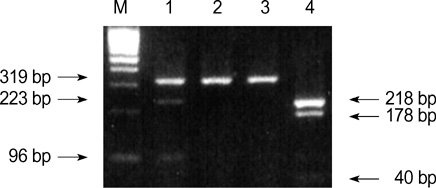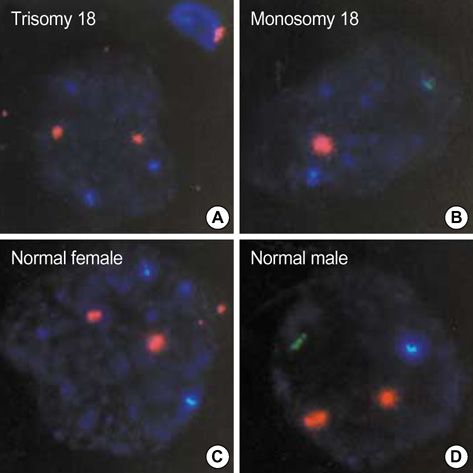J Korean Med Sci.
2007 Jun;22(3):572-576. 10.3346/jkms.2007.22.3.572.
Preimplantation Genetic Diagnosis for Ornithine Transcarbamylase Deficiency by Simultaneous Analysis of Duplex-nested PCR and Fluorescence In Situ Hybridization: A Case Report
- Affiliations
-
- 1Laboratory of Reproductive Biology & Infertility, Cheil General Hospital & Women's Healthcare Center, Kwandong University College of Medicine, 1-19 Mukjeong-dong, Jung-gu, Seoul, Korea. junjh55@hanmail.net
- 2Department of Obstetrics and Gynecology, Cheil General Hospital & Women's Healthcare Center, Kwandong University College of Medicine, Seoul, Korea.
- 3Medical Genetics Clinic & Laboratory, Department of Pediatrics, Asan Medical Center, University of Ulsan College of Medicine, Seoul, Korea.
- KMID: 1778375
- DOI: http://doi.org/10.3346/jkms.2007.22.3.572
Abstract
- Ornithine transcarbamylase (OTC) deficiency is an X-linked co-dominant disorder. A couple, with a previous history of a neonatal death and a therapeutical termination due to OTC deficiency, was referred to our center for preimplantation genetic diagnosis (PGD). The female partner has a nonsense mutation in the exon 9 of the OTC gene (R320X). We carried out nested polymerase chain reaction (PCR) for R320X mutation and fluorescence in situ hybridization (FISH) for aneuploidy screening. Among a total of 11 embryos, two blastomeres per embryo from 9 embryos were biopsied and analyzed by duplex-nested PCR and FISH, and one blastomere per embryo from 2 embryos by only duplex-nested PCR. As a result of PCR and restriction fragment length polymorphism analysis, four embryos were diagnosed as unaffected embryos having the normal OTC gene. Among these embryos, only one embryo was confirmed as euploidy for chromosome X, Y and 18 by FISH analysis. A single normal embryo was transferred to the mother, yielding an unaffected pregnancy and birth of a healthy boy. Based on our results, PCR for mutation loci and FISH for aneuploidy screening with two blastomeres from an embryo could provide higher accuracy for the selection of genetically and chromosomally normal embryos in the PGD for single gene defects.
Keyword
MeSH Terms
Figure
Reference
-
1. Munne S, Sultan KM, Weier HU, Grifo JA, Cohen J, Rosenwaks Z. Assessment of numerical abnormalities of X, Y, 18 and 16 chromosomes in preimplantation embryos before transfer. Am J Obstet Gynecol. 1995. 172:1191–1201.2. Verlinsky Y. Preimplantation genetic diagnosis. J Assist Reprod Genet. 1996. 13:87–89.
Article3. Delhanty JD. Chromosome analysis by FISH in human preimplantation genetics. Hum Reprod. 1997. 12(11):Suppl. 153–155.4. Lim CK, Jun JH, Min DM, Lee HS, Kim JY, Koong MK, Kang IS. Efficacy and clinical outcome of preimplantation genetic diagnosis using FISH for couples of reciprocal and Robertsonian translocations: the Korean experience. Prenat Diagn. 2004. 24:556–561.5. Lim CK, Min DM, Lee HS, Byun HK, Park SY, Ryu HM, Kim JY, Koong MK, Kang IS, Jun JH. Improvement of pregnancy rate in preimplantation genetic diagnosis with FISH procedure by the laboratory optimization and experiences. Korean J Fertil Steril. 2004. 31:29–39.6. Gianaroli L, Magli MC, Ferraretti AP, Munne S. Preimplantation diagnosis for aneuploidies in patients undergoing in vitro fertilization with a poor prognosis: identification of the categories for which it should be proposed. Fertil Steril. 1999. 72:837–844.
Article7. Munne S, Magli C, Cohen J, Morton P, Sadowy S, Gianaroli L, Tucker M, Marquez C, Sable D, Ferraretti AP, Massey JB, Scott R. Positive outcome after preimplantation diagnosis of aneuploidy in human embryos. Hum Reprod. 1999. 14:2191–2199.8. Lissens W, Sermon K. Preimplantation genetic diagnosis: current status and new development. Hum Reprod. 1997. 12:1756–1761.9. Ray PF, Handyside AH. Increasing the denaturation temperature during the first cycles of amplification reduces allele dropout from single cells for preimplantation genetic diagnosis. Mol Hum Reprod. 1996. 2:213–218.10. Malcov M, Schwartz T, Mei-Raz N, Yosef DB, Amit A, Lessing JB, Shomrat R, Orr-Urtreger A, Yaron Y. Multiplex nested PCR for preimplantation genetic diagnosis of spinal muscular atrophy. Fetal Diagn Ther. 2004. 19:199–206.
Article11. Lee HS, Choi HW, Lim CK, Koong MK, Kang IS, Yoo HW, Choi JH, Jun JH. Identification of a novel single nucleotide polymorphism of HADHA gene at a referred primer-binding site during pre-diagnostic tests for preimplantation genetic diagnosis. J Korean Med Sci. 2006. 21:794–799.
Article12. Lindgren V, de Martinville B, Horwich AL, Rosenberg LE, Francke U. Human ornithine transcarbamylase locus mapped to band Xp21.1 near the Duchenne muscular dystrophy locus. Science. 1984. 226:698–700.
Article13. Horwich AL, Fenton WA, William KR, Kalousek F, Kraus JP, Doolittle RF, Konigsberg W, Rogenberg LE. Structure and expression of a complementary DNA for the nuclear coded precursor of human mitochondrial ornithine transcarbamylase. Science. 1984. 224:1068–1074.
Article14. Hata A, Tsuzuki T, Shimada K, Takiguchi M, Mori M, Matsuda I. Structure of the human ornithine transcarbamylase deficiency. Am J Hum Genet. 1988. 48:212–222.15. Pelet A, Rotig A, Bonaiti-Pellie C, Rabier D, Cormier V, Toumas E, Hentzen D, Saudubray JM, Munnich A. Carrier detection in a partially dominant X-linked disease: ornithine transcarbamylase deficiency. Hum Genet. 1990. 84:167–171.
Article16. Hudak ML, Douglas Jones M, Brusilow SW. Differentiation of transient hyperammonemia of the newborn and urea cycle enzyme defects by clinical presentation. J Pediatr. 1985. 107:712–719.
Article17. Tuchman M, Jaleel N, Morizono H, Sheehy L, Lynch MG. Mutations and polymorphisms in the human ornithine transcarbamylase gene. Hum Mutat. 2002. 19:93–107.
Article18. Yamaguchi S, Brailey LL, Morizono H, Bale AE, Tuchman M. Mutation and polymorphisms in the human ornithine transcarbamylase (OTC) gene. Hum Mutat. 2006. 27:626–632.19. Ray PF, Gigarel N, Bonnefont JP, Attie T, Hamamah S, Frydman N, Vekemans M, Frydman R, Munnich A. First specific preimplantation genetic diagnosis for ornithine transcarbamylase deficiency. Prenat Diagn. 2000. 20:1048–1054.
Article20. Verlinsky Y, Rechitsky S, Verlinsky O, Strom C, Kuliev A. Preimplantation diagnosis for ornithine transcarbamylase deficiency. Reprod Biomed Online. 2000. 1:45–47.
Article21. Yoo HW, Kim GH, Lee DH. Identification of new mutations in the ornithine transcarbamylase (OTC) gene in Korean families. J Inherit Metab Dis. 1996. 19:31–42.
Article22. Rechitsky S, Freidine M, Verlinsky Y, Strom CM. Allele dropout in sequential PCR and FISH analysis of single cells (cell recycling). J Assist Reprod Genet. 1996. 13:115–124.
Article23. Thornhill AR, Monk M. Cell recycling of a single human cell for preimplantation diagnosis of X-linked disease and dual sex determination. Mol Hum Reprod. 1996. 2:285–289.24. Strom CM, Ginsberg N, Rechitsky S, Cieslak J, Ivakhenko V, Wolf G, Lifchez A, Moise J, Valle J, Kaplan B, White M, Barton J, Kuliev A, Verlinsky Y. Three births after preimplantation genetic diagnosis for cystic fibrosis with sequential first and second polar body analysis. Am J Obstet Gynecol. 1998. 178:1298–1306.
Article25. Wu K, Cuppens H, Buyse I, Decorte R, Marynen P, Gordts S, Cassiman JJ. Co-amplification of the cystic fibrosis delta F508 mutation with the HLA DQA1 sequence in single cell PCR: implications for improved assessment of polar bodies and blastomeres in preimplantation diagnosis. Prenat Diagn. 1993. 13:1111–1112.26. Thornhill AR, McGrath JA, Eady RA, Braude PR, Handyside AH. A comparison of different lysis buffers to assess allele dropout from single cells for preimplantation genetic diagnosis. Prenat Diagn. 2001. 21:490–497.
Article27. Piyamongkol W, Bermudez MG, Harper JC, Wells D. Detailed investigation of factors influencing amplification efficiency and allele dropout in single cell PCR: implications for preimplantation genetic diagnosis. Mol Hum Reprod. 2003. 9:411–420.
Article28. Choi HW, Lee HS, Lim CK, Koong MK, Kang IS, Jun JH. Reliability of the single cell PCR analysis for preimplantation genetic diagnosis of single gene disorders. Korean J Fertil Steril. 2005. 32:293–300.29. Dreesen J, Jacobs L, Bras M, Herberg J, Dumoulin JC, Geraedts JP, Evers JL, Smeets HJ. Multiplex PCR of polymorphic markers flanking the CFTR gene: a general approach for preimplantation genetic diagnosis of cystic fibrosis. Mol Hum Reprod. 2000. 6:881–885.
Article30. Eftedal I, Schwartz M, Bendtsen H, Andersen A, Zieve S. Single intragenic microsatellite preimplantation enetic diagnosis for cystic fibrosis provides positive allele identification of all CFTR genotypes for informative couples. Mol Hum Reprod. 2001. 7:307–312.31. Goossens V, Sermon K, Lissens W, Vandervorst M, Vanderfaeillie A, De Rijcke M, De Vos A, Henderix P, Van De Velde H, Van Steirteghem A, Liebaers I. Clinical application of preimplantation genetic diagnosis for cystic fibrosis. Prenat Diag. 2000. 20:571–581.
Article32. Lee HS, Choi HW, Lim CK, Park SY, Kim JY, Koong MK, Jun JH, Kang IS. Efficacy of duplex-nested PCR and fluorescent PCR in the preimplantation genetic diagnosis for Duchenne muscular dystrophy. Korean J Fertil Steril. 2005. 32:17–26.
- Full Text Links
- Actions
-
Cited
- CITED
-
- Close
- Share
- Similar articles
-
- Successful Preimplantation Genetic Diagnosis for Ornithine Transcarbamylase Deficiency, Junctional Epidermolysis Bullosa and Lactic Acidosis Using Duplex Nested PCR: Delivery of Healthy Baby by Specific Preimplantation Genetic Diagnosis for Ornithine Tran
- Reliability of the Single Cell PCR analysis for Preimplantation Genetic Diagnosis of Single Gene Disorders
- A Case of Molecular Diagnosis of Ornithine Transcarbamylase Deficiency
- Development of Multicolor Fluorescence In Situ Hybridization for Preimplantation Genetic Diagnosis in Human Embryos
- Clinical application of preimplantation genetic diagnosis (PGD) using fluorescence in-situ hybridization to balanced reciprocal or Robertsonian translocation carriers in human IVF-ET program




